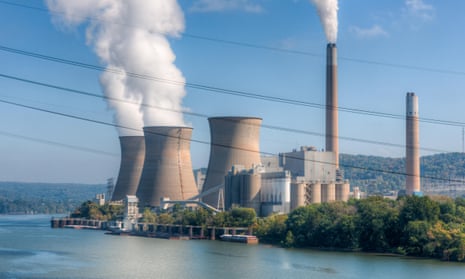The US is on course to miss its emissions reduction target agreed in the Paris climate accord nine months ago, with new research finding that the world’s largest historical emitter doesn’t currently have the policies in place to meet its pledge.
Even if the US implements a range of emissions-slashing proposals that have yet to be introduced, the nation could still overshoot its 2025 target by nearly 1bn tonnes of greenhouse gases. This failure would have profound consequences for the US’s position as a climate leader, as well for the global effort to stave off the dangerous heatwaves, sea level rise and extreme weather associated with climate change.
“If the policies were locked today, there would be a low likelihood of meeting the target,” said Jeffery Greenblatt, scientist at the Lawrence Berkeley National Laboratory and lead author of the study, published in Nature.
“I wouldn’t disparage the US’s efforts so far, but we need to do more as a nation and globally to reduce emissions. However we splice it, that’s hard to do. We can’t make small alterations to our economy – we need fundamental changes in how we get and use energy.”
The US pledged to reduce its greenhouse gas emissions by 26% to 28% by 2025, based in 2005 levels, at last year’s landmark Paris climate deal. At the time, Barack Obama hailed the US as “the global leader in fighting climate change”.
But the new study used previous government projections combined with updated emissions data to forecast that even if the president’s centerpiece Clean Power Plan was to go ahead, the US would fall short of its target by 551m to 1.8bn tonnes of greenhouse gases. Adding in all proposed reforms, to areas such as building codes, emissions standards for trucks and fertilizers, would still see a shortfall of 356m to 924m tonnes by 2025.
While the US still has time to close this gap, the study warns that additional measures will probably be required at a time when action on climate change is anathema to Republicans whose presidential candidate, Donald Trump, has called global warming a “hoax” and “bullshit”.
Greenblatt said: “It’s good to set ambitious targets, it pushes us to be creative and find ways to meet them. We won’t get there with existing policies but it doesn’t mean we are doomed. This is a call to action to ensure we close the remaining gap.”
The US has been overtaken by China in recent years as the world’s largest emitter but still expels more than 6.8bn tonnes of greenhouse gases a year from energy, transportation and agriculture. While US emissions have edged downwards over the past decade, Obama’s linchpin climate policy, the Clean Power Plan, has been enmeshed in a legal battle waged by leaders of 27 American states. Court hearings over the legality of plan, which would place emissions limits upon each state, begin on Tuesday.
The Paris climate deal, which Trump has said the US will exit should he win the presidency, calls for emissions reductions from 195 signatory countries in order to prevent global temperatures rising more than 2C above pre-industrial levels.
However, a string of record-breaking months of heat in 2016 has raised concerns that a more aspirational target of a 1.5C limit is already out of reach. Soberingly, the 2C guardrail is also in jeopardy, with several analyses showing that nations’ emissions reduction pledges are insufficient.
Calculations released this month by the Massachusetts Institute of Technology found that proposed emissions cuts would lead to a 3.5C increase in average global temperatures by 2100. This warming would probably trigger a range of dangerous environmental changes for humans and other species.
John Sterman, director of the MIT Sloan Sustainability Initiative, said the new emissions projection study, which he wasn’t involved in, was “sound” in its conclusions.
“The target is absolutely not beyond our reach, it’s just not likely with current policy,” he said. “We have the technology to dramatically cut emissions and economically we know it’s affordable.
“The problem is a political problem and an implementation problem. The US, and the world, needs deeper and sooner cuts.”
Sterman said cheap gasoline and natural gas prices in the US have led to overconsumption of fossil fuels and slowed efforts to improve energy efficiency. He added that putting a price on carbon, which has been done in California but fiercely resisted by Republicans nationally, would provide the largest single shove towards meeting the 2025 target.
“If you had to take one policy to a desert island, it would be a price on carbon,” Sterman said. “But it’s not the only one. There’s no silver bullet to dealing with climate change, there’s silver buckshot.”

Comments (…)
Sign in or create your Guardian account to join the discussion